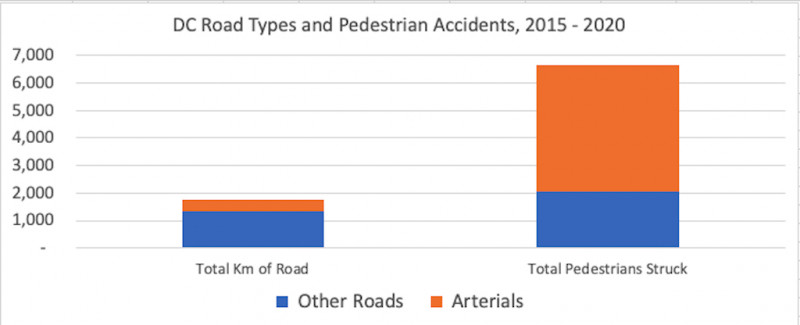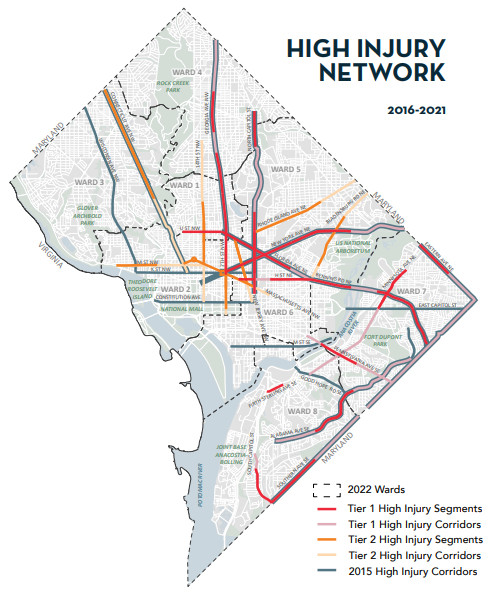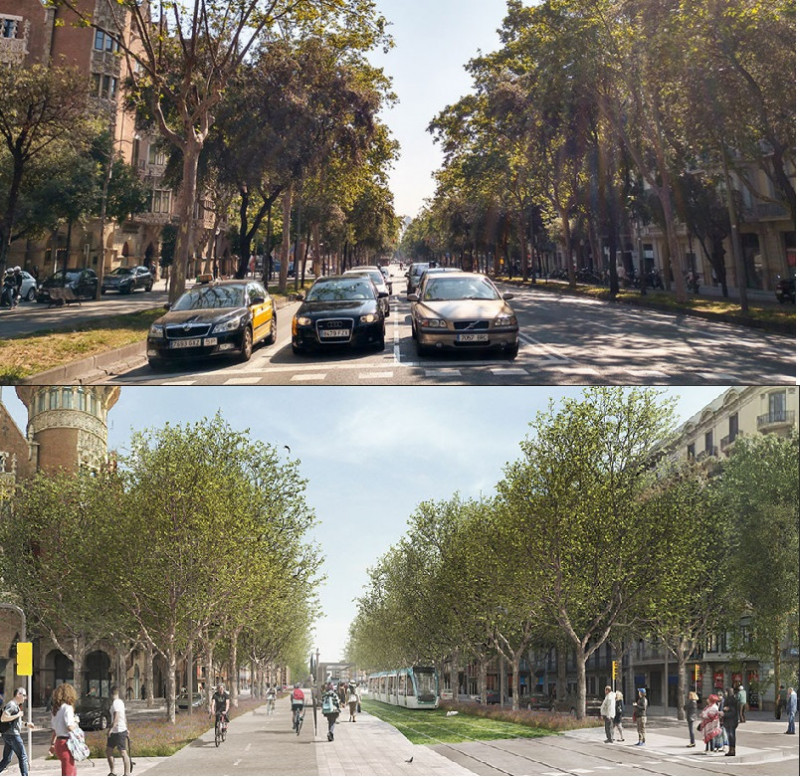Go big or go home: A real safety vision for DC’s deadliest streets
_800_536_90.jpg)
Morning Traffic, 14th Street NW by Jean & Oliver licensed under Creative Commons.
This post is the fifth in an ongoing series about reducing the trips people take by car in DC.
- Part I: Vision Zero is meaningless unless we get more drivers off the road
- Part II: DC’s current car trip reduction goal is woefully inadequate
- Part III: Driving is the new smoking: Lessons from America’s public health victory over tobacco
- Part IV: How much do people in the District really drive?
Last month, Mayor Muriel Bowser released an update to her Vision Zero program. The new document contains a number of important, and overdue, acknowledgments, starting with a plain admission that the original Vision Zero program has fallen short as traffic deaths have risen, not fallen, since it was announced in 2015.
Other highlights of the update include a goal to lower vehicle-miles-traveled (VMT) per capita; an embrace of the safe-systems approach; and a new collection of stories from victims of traffic violence, and their friends and families.
One of the most promising features of the update is a more focused approach to high-speed arterials, which make up a minority of the District’s roads, but are where a majority of crashes, injuries, and deaths occur. If DC’s leaders believe that no one should die or suffer life-altering injuries as a result of a crash, they should spend the most time and money fixing deadly arterials before anything else.
Crashes involving pedestrians compared to total kms by type of road. Source: Charlotte Jackson-Lee. 
Though the 2015 Vision Zero action plan made note of the dangers of arterials, the update has a more specific plan of attack, identifying a High Injury Network (HIN) with two tiers of danger. The HIN is, functionally, a wishlist for District leaders.
In good news, every single one of these HIN corridors save one, Eastern Avenue, overlaps with MoveDC’s Transit Priority Map and/or the Bicycle Master Plan, meaning lawmakers already have funded, and should be funding more, changes on these streets in the coming years.
High Injury Network corridors from updated Vision Zero plan. 
However, the scope of those bus and bike projects so far has generally been tactical, often using a “paint and posts” approach to add protected infrastructure without having to significantly change the size of the right-of-way or involve heavy construction. Limited interventions will not be sufficient to make many of these dangerous, pseudo-highway corridors, like New York Avenue or Southern Avenue, truly safe.
If the District is serious about preventing all deaths on arterials, it needs a proactive plan, beyond the (useful!) HIN blueprint.
I propose here to launch a dedicated capital project to systematically redesign each corridor on the HIN, tentatively called the Corridor Modernization Plan.
A learned example
The inspiration for such a plan is one of the District’s success stories from the last twenty years, its school modernization program.
In the 1990s, DC’s school facilities were in a state of almost complete disrepair. A 1998 US Army Corp of Engineers report found that 70% of DCPS facilities “were in poor physical condition.” After outrage and even a lawsuit from parents, the Board of Education eventually approved a $3.5 billion dollar Master Plan in 2001 to not just renovate (which would have simply brought facilities back to their original condition) but modernize (transform facilities to serve the future needs) DCPS’ physical assets. Most notably, the modernization plan laid out a systematic approach: successive waves of 10 schools at a time over a 10-15 year horizon.
Dumbar High School Re-Build Timelapse Video
The school modernization plan has not been without issues. Despite the bold vision behind it, the plan languished for lack of dedicated funding until a 2006 law finally established one. And a 2015 report from the DC Auditor cataloged a series of oversight failures by the Fenty and Gray administrations, the Office of Public Education Facilities Modernization, and the Department of General Services, including poor financial management and lack of transparency in which schools were chosen for modernization each year. The Council later passed a law formalizing a prioritization process, though political difficulties accessing the data necessary continued to plague the program.
Despite these faults, the overall result of the school modernization program is a success. The physical condition of a number of DC’s schools has largely gone from an embarrassment to a strength, and is a testament to the District’s ability to accomplish big projects when its leaders devote the proper political and financial capital to meet the scale of the need.
DGS won an award from the Urban Land Institute in 2020 for the school modernization plan. Source: Perkins-Eastman 
The comparison of how the District made real progress on its crumbling schools and how it can do the same for its dangerous arterials is an apt one. Most corridors were last redesigned in the middle of the previous century and no longer serve our present uses, let alone our future needs.
The 2015 Vision Zero action plan, and its recent update, largely traffic in operational work, such as data collection, planning, and education, rather than capital projects. The bus-priority and projected bike lane plans are excellent, but are not intended to be comprehensive, permanent safety projects.
What the District, its residents, and its visitors need are big investments in large-scale capital projects that have the power and vision to fundamentally reshape the right-of-way, not just flex-post over the problems.
A Corridor Modernization Plan with a dedicated funding stream, a priority list based on criteria and defined inputs, and a series of deadlines is necessary to prevent anyone from dying in a crash on any of these streets.
Funding a Corridor Modernization Plan will be a heavy lift, on top of fully fleshing out the funding for the Vision Zero omnibus bill. In 2007 the school modernization program was budgeted at $3.5 billion dollars over fifteen years. This past year, Mayor Bowser committed another $2.5 billion over the next six.
Schools and streets are an apple-to-orange comparison, but the total cost here is probably the same ballpark. Benchmarking off of the K St transitway project, which is projected to cost $110 million to do significant streetscape construction, the two dozen corridors on the HIN map would probably total in the $3 billion+ range.
The schools program has largely been paid through low-cost general obligation (G.O.) bonds (although the aforementioned audit took issue with this financing strategy as violating the intent of the original modernization legislation’s plan to use “pay as you go” general revenue). Federal funding, particularly from the recent Bipartisan Infrastructure Law, is also a key opportunity to supplement local funds, as Bowser’s recent Build Back Better task force report highlights.
Getting it right
But getting the plan and funding in place is only half the battle. Just as important as whether the District modernizes corridors is how they do it. The simple reason arterials are so dangerous is that they are just too big. Wide, open roads enable drivers to speed, especially when there’s less congestion, and higher speeds are the most significant factor in the frequency and lethality of crashes.
For all the complexity of traffic engineering, the main solution to making an arterial less deadly isn’t particularly sophisticated: Take lanes away from drivers. Commonly referred to as “dieting” a road, visually and physically narrowing the right-of-way forces drivers to slow down. And redistributing that extra space to bus lanes, bike lanes, sidewalks, and green space provides safer ways to move more people while making streets more inviting for commercial, social, and recreational activity.
Level, uncluttered & wide cycle tracks. Space for people of all ages and abilities to make their journeys without using or interacting with multi-ton vehicles. pic.twitter.com/l5bxXzkpYe
— Infrastructure CGIs (@InfraCGI) July 29, 2022
CGI rendering example of how wide roads can be redesigned for safety and livability. Source @InfraCGI.
The adoption of a safe-systems approach, which DDOT says it has done in its Vision Zero update, should indicate that decision-makers, planners, and engineers understand that induced demand means we cannot design streets to accommodate the maximum possible car traffic. In theory, this means that the District should be designing for lower speeds and, yes, fewer cars. That is, at least, what the District has already committed to with its MoveDC and Sustainable DC plans, and it’s the position that a majority of candidates for office in DC this cycle agreed with on GGWash’s endorsement questionnaire.
And, we don’t lack for models: Barcelona, Paris, New York, Berlin, Bogotá, Utrecht, and dozens more have taken arterials just like ours and redesigned them to intentionally lower car volumes.
Present condition of the Avinguda Diagonal in Barcelona (top) A rendering of proposed changes of the Avinguda Diagonal in Barcelona. (bottom) Source: City of Barcelona. 
Big results require big plans
Bowser is seeking “transformational ideas” following her reelection to a third term. That’s the kind of ambition I want to see devoted to overhauling the District’s deadliest corridors. Capitulating to 85th-percentile engineering logic or political status-quo bias will just lead to an ineffective middle ground, where considerable reconstruction of these major thoroughfares will understandably cause backlash from constituents, but not provide sophisticated or safe enough designs to justify the effort. Such half-baked, unimpressive results “modernizing” an initial round of corridors will likely sap the political will to complete any full plan.
This is why my foundational point about naming the clear goal of car trip reduction is relevant. Starting from that position allows leaders, both elected and appointed, to be honest with their constituents about how removing parking and travel lanes—often perceived as inconveniencing drivers— is, realistically, the most reliable way to achieve the safety and climate goals, such as zero road deaths by 2025 and reducing greenhouse gas emissions from transportation by 60 percent, to which the District has committed itself.
The Vision Zero action plan was released nearly a decade ago, and in the intervening years the District has largely pursued insufficient, marginal interventions, such as installing a handful of haphazard speeding cameras, marketing ineffectual education campaigns, and installing mostly reactive, small-scale street design changes.
We’ve already lost 10 years’ worth of time, money, and effort avoiding the expensive but effective capital projects I’ve described here for being too politically difficult. Worse, hundreds of people have lost their lives, and thousands more have been injured, because of the District’s meek and misguided investments. We don’t have to say the same in another decade.
